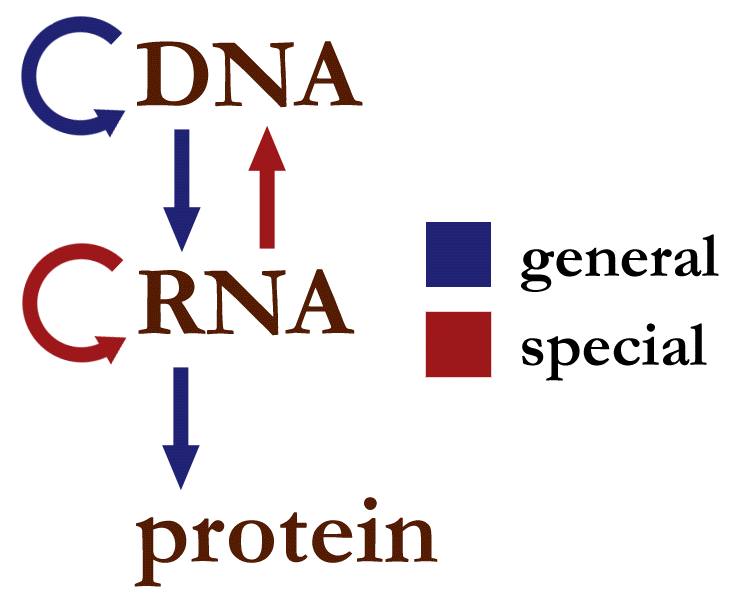 |
| Picture source: Wikimedia
The central dogma of biology is a fundamental concept in molecular biology that describes the flow of genetic information from DNA to RNA to proteins. According to the central dogma, DNA contains the genetic information that is used to produce proteins, which carry out most of the functions in a cell.
However, there are some exceptions to the central dogma. One of the main exceptions is the process of reverse transcription, which is the synthesis of DNA from an RNA template. This process occurs in some viruses, such as HIV, and in some eukaryotic cells during the process of gene expression.
Another exception to the central dogma is the process of RNA editing, which is the modification of RNA molecules after they are transcribed from DNA. RNA editing can involve the addition or deletion of nucleotides, or the substitution of one nucleotide for another. This process can change the sequence of the RNA molecule and, as a result, the protein that it encodes.
Another exception to the central dogma is the process of RNA interference (RNAi), which is a mechanism that cells use to regulate gene expression. RNAi involves the degradation of specific RNA molecules by enzymes called RNases. This process can prevent the production of proteins that are encoded by the degraded RNA, which can have important effects on cell function.
While the central dogma of biology is a fundamental concept in molecular biology, there are some exceptions to this rule. Understanding these exceptions can provide important insights into the complex processes that occur within cells.
|
वर्ग Viruses
Central Dogma of Biology
 |
| Picture source: Wikimedia |
The central dogma of molecular biology is a term coined by Francis Crick to describe the flow of genetic information in living organisms. This flow of information is essential for the functioning of all cells, and is the basis for many of the fundamental processes of life, such as growth, development, and reproduction.
The central dogma of molecular biology states that genetic information flows from DNA to RNA to protein. This process begins with the transcription of DNA into RNA, which is carried out by enzymes called RNA polymerases. RNA polymerases bind to specific sequences in the DNA called promoters, and then use the DNA as a template to synthesize an RNA molecule that is complementary to the DNA.
This RNA molecule, also known as messenger RNA (mRNA), is then used as a template for the synthesis of a protein molecule. This process, known as translation, is carried out by ribosomes, which are cellular structures that are responsible for protein synthesis. The ribosome reads the sequence of nucleotides in the mRNA, and uses this information to synthesize a protein molecule with a specific sequence of amino acids.
The flow of genetic information from DNA to RNA to protein is essential for the functioning of all cells. DNA contains the genetic information that is required for the synthesis of all of the proteins that are necessary for life. The process of transcription and translation allows cells to produce the proteins that they need in order to carry out their functions.
The central dogma of molecular biology has been supported by a wealth of experimental evidence, and it is considered to be one of the fundamental principles of molecular biology. It has also been extended and refined over time to include additional details about the process of gene expression, such as the role of regulatory elements and the mechanisms by which genes are turned on and off.
In addition to its importance in molecular biology, the central dogma has also had a significant impact on other fields of science, such as medicine and biotechnology. For example, the ability to manipulate the flow of genetic information has led to the development of powerful new tools for studying and treating genetic diseases, as well as for producing valuable proteins and other biomolecules for use in research and industry.
The central dogma of molecular biology is a key concept that helps to explain how genetic information is used and transmitted in living organisms. It is a fundamental principle that has had a profound impact on our understanding of the basic processes of life, and continues to be an important area of research in the field of molecular biology.
